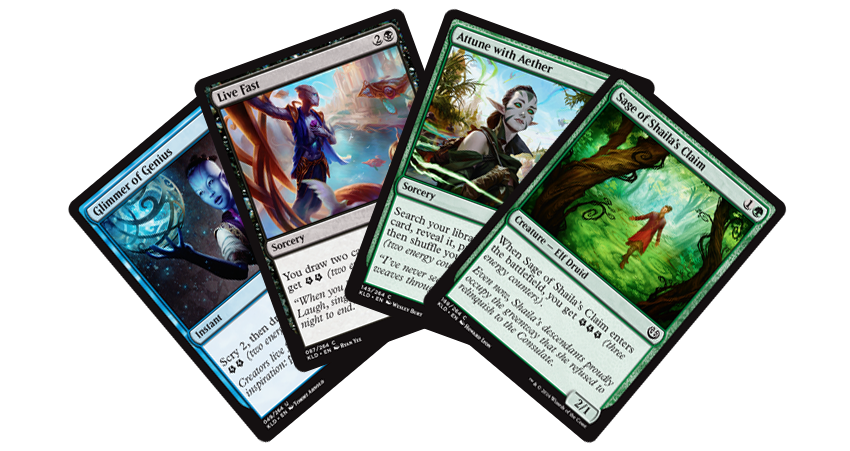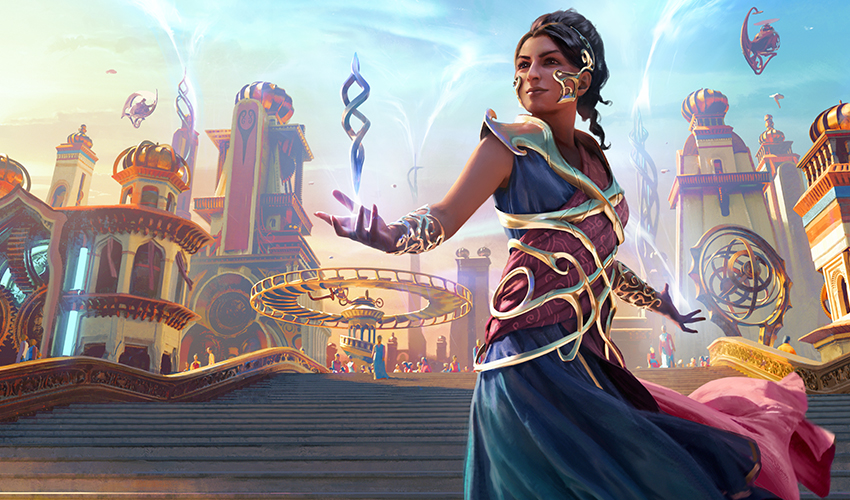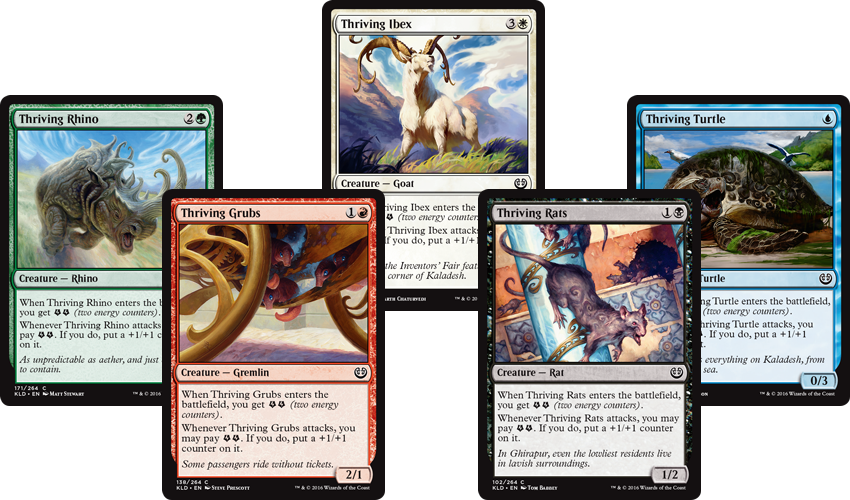"Do You Feel Lucky, Aetherpunk?" Part 2
Last week, I started my card-by-card design stories for Kaladesh. I have a lot of stories, so I'll continue today.
Elegant Edgecrafters/Ghirapur Guide
In Shadows over Innistrad, we tried out a new evasive ability called skulk (creatures couldn't block a creature with skulk if it had a greater power than that creature). We had our eye on skulk as a possible evergreen ability, but it didn't work out. Conversation about skulk got R&D to discuss various other possible evasive abilities. One suggestion, nicknamed "daunt" in R&D ("can't be blocked by creatures with power 2 or less"), ended up on two cards in Kaladesh. I'm not quite sure about the future of this mechanic, but I'm interested to see how it plays out. I like that it has a little of the game play of trample, with fewer words and a template that's much easier to understand.
Glimmer of Genius/Live Fast/Attune with Aether/Sage of Shaila's Claim

Originally, all energy cards both gave and used energy. As we played around with Limited, we realized that we needed to provide a little more access to energy. These cards are the few cards in the set that give you energy without also having a way for you to spend it. These cards all have a basic effect that is useful even if you don't care about the energy and are all geared toward Limited play. For those curious, we have no cards with a way to spend energy without a way to acquire it. (Well, the audience at "PAX Invents the Card" at PAX West made one, but that's it.)
Glint-Nest Crane
We spent a lot of time, while searching for mechanics, trying to make sure that one of them was artifact centered. After all, this block had a strong artifact component. We wanted to make sure artifacts mattered in game play. Energy thematically made great sense on Kaladesh, and it felt like a good mechanic for a set where artifacts were centered on the idea of technology. Vehicles were also a perfect fit for this world flavor-wise. Fabricate reinforced the themes of +1/+1 counters and artifact creature tokens, which seemed to be a natural for the themes of the set. The problem was that none of them focused on artifacts.
Sure, all Vehicles were artifacts and fabricate made artifact creature tokens, but none of the mechanics cared that you had artifacts. Eventually, we decided that we could hit the "artifacts matter" theme without specifically having a mechanic carry that weight. By carefully designing cards on a case-by-case basis, we could make the theme strongly present. Glint-Nest Crane is just an example of one of those cards, many of which are sprinkled throughout the set.
I bring this up because I know it's very easy to think of the framework of the set being held up by the mechanics. But that's not always necessary, as Kaladesh demonstrates.
Ovalchase Dragster
Of all the Vehicles, this was the one that made it through the process with the fewest changes. Originally called Blisteringly Fast Firecar, this Vehicle is pretty close in its final version to its early printing. It was a 6/1 with trample and crew 1 (although at the time, that meant tap one creature as opposed to one power worth of creatures). It didn't originally have haste because in the early version of Vehicles, all Vehicles had haste. You were allowed to attack with them the turn they entered the battlefield. That was changed during development for power concerns. Haste was added to keep the flavor of this card and have it act similarly to how it was originally designed.
Panharmonicon
As I explained in my first Kaladesh preview article, I co-lead the design with Shawn Main. He and I used to meet once a week to talk through how we felt the design was going. One week, Shawn commented that he felt we were low in wacky, build-around artifacts. Kaladesh was an artifact block and Shawn (rightfully) believed that players would expect a number of Johnny/Jenny-friendly artifacts. I agreed and told him I'd put together some designs.
My goal was to create cards that both had the wacky feeling we wanted and played well with the set's themes. The trick was that I wanted the second goal to be as subtly done as possible. So I created a long list of cards each with names like Whatchamacallit and Thingamajig.
Panharmonicon came about because I realized that a lot of the cards made use of "enters the battlefield" (ETB) effects. Most low-rarity energy cards gave you energy as an ETB effect. Fabricate was all ETB effects. A number of artifacts had ETB effects. The set was full of them. Okay, most Magic sets are full of them, but Kaladesh was above average due to the mechanics and artifact theme. Also, I love doubling things, so why not make a card that doubles ETB effects?
I wasn't sure if the card would be problematic in development or even be something that could be templated, but I fell in love with it instantly. I was obviously delighted when it actually made it to print as it was my favorite of the cards I designed. So, please, you all have fun with it.
Pia Nalaar
I love it when game mechanics can tell a story. Let's start by reminding you all what Pia and Kiran Nalaar did. (This card was in Magic Origins from Chandra's origin story.)
Pia costs less as she is missing Kiran, but she's managed to step up and be the 2/2 they were as a couple. She only enters with one Thopter though, instead of two (as Kiran is missing). She also still sacrifices an artifact for an effect, but she's chosen to try something different, because dealing two damage to target creature or player brings up too many memories.
I don't want to give away too much of the story, but the card mechanic does a great job of helping establish who she is, modern day, as a character. Also, I'm happy that at least one of the Gatewatch has a living parent. (There's still hope for Jace, but at best they're alive and he has no memory of them.)
Revoke Privileges
This card is an excellent example of how basic effects have to be tweaked based on the environment that you're using them in. Revoke Privileges started as a Pacifism. I don't remember if it was a reprint or a Pacifism tweak, but basically it prevented a creature from attacking or blocking. One small problem: The rules didn't prevent a Pacified creature from crewing a Vehicle, so the card ending up being pretty useless as Vehicles are all over Kaladesh Limited.
One meeting, we're talking about the card and I say, "So I cast a spell on a creature which instills within them a desire for nonviolence. They no longer want to be part of the fight. So why are they hopping in and driving a tank?" We then added the "or crew Vehicles" because it made the card match the flavor in this environment.
I always talk about how I like it when we're able to make cards that only make sense in the environment they appear in. These kind of tweaks are a lesser version of this issue, but still something I like to see.
Saheeli Rai
One of the things we do when we first start figuring out how to market a set is to begin thinking about what the "key art" is. The key art is an image that is the first one we show, which helps set the tone for the block. For example, for Kaladesh, this was the key art:

Saheeli first came about because we were trying to figure who was on the key art. Usually it's a Planeswalker. Chandra is the main character and it's her story, so she was the first assumption. Here's the problem: The first set wanted to set up the glory that is Kaladesh. We wanted to highlight the inventor feel, and create a sense of wonder and optimism. Chandra isn't an inventor and, while this is her home, it's not a place she feels all that comfortable in. Remember, last time Chandra was here, she watched her parents die (well, she thought her mother had died) and was just about to be executed when her spark ignited.
Nissa is also an outsider, so she wasn't a great choice. We thought about Tezzeret (he doesn't have a Planeswalker card in this set, but we could have made it so he did). He does convey artifacts, but he's not exactly the poster child for wonder and optimism. We thought about Dovin Baan. He's at least a native of Kaladesh, but he really didn't convey the sense of invention that we wanted. What if we made a brand new Planeswalker that could capture exactly the feel we wanted? She could be a native of Kaladesh that is also an inventor. And that is how Saheeli Rai first came to exist.
The one other interesting story about this card has to do with her middle ability. For a while in the set, we had an ability called "reverse engineer" based on the card Heat Shimmer from Lorwyn.
Instead of copying a creature, reverse engineer made a token copy of any artifact. It gained haste if a creature, and then was sacrificed at end of turn. The mechanic was a lot of fun and definitely made you feel like an inventor, but it proved to be too easy to exploit and had to be removed for developmental concerns. Saheeli's middle ability is a nod to reverse engineer. It might be broken as a whole mechanic, but as a single loyalty ability on a Planeswalker it was deemed okay.
Self-Assembler
R&D has a nickname for cards that make a nostalgic throwback to cards from the past. We call them "time spiral" cards as those type of cards were all over the set of that name. We don't do them anywhere close to the volume that Time Spiral had, but one every once in a while is fun for the old timers. Self-Assembler is the time spiral card of Kaladesh. Do you know what card this card is referencing?
This card:
This time spiral card is a throwback to Magic's second expansion, Antiquities, and the card Mishra's Factory. The card is a land that you can spend one generic mana to turn it into a 2/2 creature until end of turn. The original card said it turned into an Assembly Worker. Later when we synced up how we were doing creature types, we ended up having to hyphenate the two words because the card has an ability that affected itself, and it needed to reference one thing. We really don't do hyphenated creature types anymore, so it's clear that this was done as an Easter Egg for the longtime fans.
Servo Exhibition
This card is another great example of how you can tweak a staple card to create something that feels much more at home in the set. Most sets have some version of this card:
White is the best color at little creatures, so we often give it a card that allows you to get two 1/1 creature tokens with one card. In Kaladesh, the dominant 1/1 creature token is a Servo, so we tweaked the card to make Servos instead. Servos are identical to Soldiers with one tiny difference—Servos are artifact creatures. It turns out that in a block about artifacts, that one little change means quite a bit, so we had to change the card from an instant to a sorcery.
Speedway Fanatic
The Pilot creature type has an interesting origin. Normally when we design sets, we get to the point where we start thinking about two-color archetypes. Traditionally white-red is an aggro attack strategy, but we realized we had the ability to do something a little different in Kaladesh. Vehicles were one of the mechanics and, at the time, crew counted the number of creatures you needed to tap rather than caring about the combined power. As such, strategies with a lot of small creatures (tokens or otherwise) worked well with Vehicles. So, we decided to make Vehicles the white-red draft strategy.
To encourage you to play a bunch of Vehicles, we found that we had to reward you for using them. As Vehicle decks were already tight on space, needing Vehicles and creatures to crew them, we chose to put the Vehicle rewards on creatures. The flavor leaped out at us and we called them Pilots. Interestingly, Vehicles would later change how crew works, making strategies other than the weenie strategy viable. But development decided to keep the theme, and the Pilot creature type, in red and white.
Thriving Ibex/Thriving Turtle/Thriving Rats/Thriving Grubs/Thriving Rhino

Mechanics fall into two camps. Some mechanics are very focused and only appear in a few colors (at least at lower rarities for Limited purposes). Other mechanics appear in all five colors, usually because they're a bigger part of establishing the flavor of the world, and usually because they're just larger mechanics that can fill more space. The second category requires something that I'm not sure I've talked about before—what I refer to as an introductory cycle.
The point of an introductory cycle is to be something that will be the first exposure of a new mechanic in play for many players. It wants to be at common and be in all five colors. Then to help make things simpler, the cycle wants to work very similarly. Usually we even use a naming convention ("Thriving" in this example) to help communicate that this is a cycle that works similarly. The idea is once you learn how one of the cycle works, you understand how the others work as well.
One of the earliest tasks in design, once you know your mechanics, is to make introductory cycles. You usually make them for most mechanics, because in the beginning you don't know yet what will be category one and what will be category two. The trick is to find the simplest, most direct (yet useful) implementation of the mechanic. For energy, I liked the idea of it being on a creature and giving it a stat boost of some kind.
If I remember correctly, the first version of this cycle gave you two energy counters. And then, for one energy, allowed you to get +1/+1 until end of turn if you paid an energy when you attacked. At some point, the boost changed to a +1/+1 counter that required two energy.
This cycle does a nice job of giving you a card you can just throw in a deck without having to think about your larger energy plan. Then, once it's in your deck, it subtly encourages you to think of adding in more energy cards. It's also about as straightforward as we can get—energy as an "enters the battlefield" effect and usable only at a specific time—to allow players to get the basics before diving into the more complex version as higher rarities.
Whirlermaker
One of our jobs in Kaladesh was to pay off the set-up that Magic Origins had done when introducing Kaladesh. Clearly there was an artifact theme, but there was one other piece that we knew we had to deliver on—Thopters. Magic Origins had a tricky problem in that it wanted the blue-red archetype, which represented Kaladesh, to be artifact themed. But the set didn't have a lot of slots for artifacts. The solution to that problem was making colored cards that created artifact creature tokens, specifically Thopters.
When making fabricate, we thought about making Thopters the token option. But flying proved to be a little too good, making players almost always choose the creature tokens over the +1/+1 counters. That meant that we had to make sure to find other places in the set to make Thopters. Whirlermaker was a straightforward way to do this. The set wanted lots of artifacts, it wanted things you could build around, and making Thopters was flavorful, so Whirlermaker was an obvious choice.
Somewhere The Hive is silently crying.
So Many Stories
I hope you had as much fun this week and last listening to the Kaladesh stories as I had telling them. As always, I want feedback about the column and the set. What are you enjoying most about Kaladesh? What are you enjoying least? Please let me know. You can write me an email or talk to me through any of my social media accounts (Twitter, Tumblr, Google+, and Instagram).
Join me next week when I answer your questions about Kaladesh design.
"Drive to Work #370—Learning from Mistakes"
Inspired by the previous podcast, I talk about how one can best learn from their mistakes.
"Drive to Work # 371—Six Ages of Design"
Also inspired by podcast #369, I explain the six ages of design, including the sixth age that I've never talked about before.
- Episode 369 Lessons Learned—Khans of Tarkir (29.1 MB)
- Episode 368 20 Lessons: Make It Personal (24.3 MB)
- Episode 367 Urza's Flux (23.4 MB)

